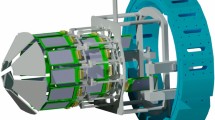Abstract
In this paper, the implantation-decay method is introduced to study the \(\beta \)-delayed charged particle decay. A silicon detector array was used for the implantation of the incident beams and for the detection of the emitted particles. An experimental measurement on the \(\beta \)-delayed particle emission from \(^{22}\)Al was used to demonstrate the method. The half-life value, charged particle spectroscopy, \(\gamma \) ray spectrum, and \(\gamma \) particle coincidence for the decay process were obtained and compared with previous experimental results for \(^{22}\)Al. The results show that the implantation-decay method, using a silicon detector array, is a suitable experimental method to study the \(\beta \)-delayed charged particle decay for proton-rich nuclei.






Similar content being viewed by others
References
M.J.G. Borge, Beta-delayed particle emission. Physica Scripta 2013, 014013 (2013). https://doi.org/10.1088/0031-8949/2013/t152/014013
M. Pfützner, Particle radioactivity of exotic nuclei. Physica Scripta 2013, 0140142013 (2013). https://doi.org/10.1088/0031-8949/2013/T152/014014
M. Pfützner, M. Karny, L.V. Grigorenko et al., Radioactive decays at limits of nuclear stability. Rev. Mod. Phys. 84, 567 (2012). https://doi.org/10.1103/RevModPhys.84.567
N. Yu, M. Enrico, F. Lidia, Two-proton sequential decay from excited states of \(^{18}\)Ne. Nucl. Sci. Tech. 24, 050517 (2013). https://doi.org/10.13538/j.1001-8042/nst.2013.05.017
Y.G. Ma, D.Q. Fang, X.Y. Sun et al., Different mechanism of two-proton emission from proton-rich nuclei \(^{23}\)Al and \(^{22}\)Mg. Phys. lett. B 743, 306–309 (2015). https://doi.org/10.1016/j.physletb.2015.02.066
D.Q. Fang, Y.G. Ma, X.Y. Sun et al., Proton-proton correlations in distinguishing the two-proton emission mechanism of \(^{23}\)Al and \(^{22}\)Mg. Phys. Rev. C 94, 044621 (2016). https://doi.org/10.1103/PhysReVC.94.044621
N. Michel, W. Nazarewicz, J. Okolowicz et al., Open problems in the theory of nuclear open quantum systems. J. Phys. G Nucl. Part. Phys. 37, 064042 (2010). https://doi.org/10.1088/0954-3899/37/6/064042
E.M. Burbidge, G.R. Burbidge, W.A. Fowler et al., Synthesis of the elements in stars. Rev. Mod. Phys. 29, 547 (1957). https://doi.org/10.1103/RevModPhys.29.547
K. Langanke, G.M. Pinedo, Nuclear weak-interaction processes in stars. Rev. Mod. Phys. 75, 819 (2003). https://doi.org/10.1103/RevModPhys.75.819
H. Grawe, K. Langanke, G.M. Pinedo, Nuclear structure and astrophysics. Rep. Prog. Phys. 70, 1525 (2007). https://doi.org/10.1088/0034-4885/70/9/R02
K. Miernik, W. Dominik, Z. Janas et al., Two-proton correlations in the decay of \(^{45}\)Fe. Phys. Rev. Lett. 99, 192501 (2007). https://doi.org/10.1103/PhysRevLett.99.192501
P. Ascher, L. Audirac, N. Adimi et al., Direct observation of two protons in the decay of \(^{54}\)Zn. Phys. Rev. Lett. 107, 102502 (2011). https://doi.org/10.1103/PhysRevLett.107.102502
M.D. Cable, J. Honkanen, R.F. Pary et al., Beta-delayed proton decay of an odd-odd \(T_{z}\)=-2 isotope, \(^{22}\)Al. Phys. Rev. C 26, 1778 (1982). https://doi.org/10.1103/PhysRevC.26.1778
M.D. Cable, J. Honkanen, R.F. Parry et al., Discovery of beta-delayed two-proton radioactivity: \(^{22}\)Al. Phys. Rev. Lett. 50, 404 (1983). https://doi.org/10.1103/PhysRevLett.50.404
B. Blank, F. Boué, S. Andriamonje et al., The spectroscopy of \(^{22}\)Al: a \(\beta \)p, \(\beta \)2p and \(\beta \alpha \) emitter. Nucl. Phys. A 615, 52 (1997). https://doi.org/10.1016/S0375-9474(96)00483-6
N.L. Achouri, F. de Oliveira Santos, M. Lewitowicz et al., The \(\beta \)-decay of \(^{22}\)Al. Eur. Phys. J. A 27, 287 (2006). https://doi.org/10.1140/epja/i2005-10274-0
Z. Sun, W.L. Zhan, Z.Y. Guo et al., The radioactive ion beam line in Lanzhou. Nucl. Instrum. Methods A 503, 496 (2003). https://doi.org/10.1016/S0168-9002(03)01005-2
D.F. Torgerson, K. Wien, Y. Fares et al., \(\beta ^+\) decay of \(^{20}\)Na. Phys. Rev. C 8, 161 (1973). https://doi.org/10.1103/Physrevc.8.161
W.X. Huang, X.J. Xu, R.C. Ma et al., Decay study of \(^{20}\)Na and its beta-delayed \(^{16}\)O recoiling. Sci. China Ser. A 40, 638 (1997). https://doi.org/10.1007/Bf02876068
J. Büscher, J. Ponsaers, R. Raabe et al., \(\beta \)-decay studies with an implantation technique. Nucl. Instrum. Methods B 266, 4652 (2008). https://doi.org/10.1016/j.nimb.2008.05.084
K.L. Laursen, O.S. Kirsebom, H.O.U. Fynbo et al., High-statistics measurement of the \(\beta \)-delayed \(\alpha \) spectrum of \(^{20}\)Na. Eur. Phys. J. A 49, 6 (2013). https://doi.org/10.1140/Epja/I2013-13079-6
O.B. Tarasov, D. Bazin, LISE++: radioactive beam production with in-flight separators. Nucl. Instrum. Methods B 266, 4957 (2008). https://doi.org/10.1016/j.nimb.2008.05.110
C. Dossta, N. Adimi, F. Aksouh et al., The decay of proton-rich nuclei in the mass A=36-56 region. Nucl. Phys. A 792, 18–86 (2007). https://doi.org/10.1016/j.nuclphysa.2007.05.004
Author information
Authors and Affiliations
Corresponding author
Additional information
This work was partially supported by the National Key R&D Program of China under Contract No. 2018YFA0404404 and the National Natural Science Foundation of China under Contract Nos. 11421505, 11475244, and 11175231.
Rights and permissions
About this article
Cite this article
Wang, YT., Fang, DQ., Xu, XX. et al. Implantation-decay method to study the \(\beta \)-delayed charged particle decay. NUCL SCI TECH 29, 98 (2018). https://doi.org/10.1007/s41365-018-0438-5
Received:
Revised:
Accepted:
Published:
DOI: https://doi.org/10.1007/s41365-018-0438-5



